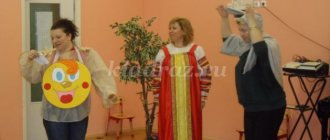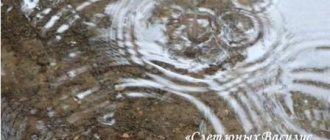Junior group. Early childhood, nursery. Children 1-4 years old
Lesson summary: telling the fairy tale “Turnip” through a tabletop theater for young children
Goal: Continue to introduce children to the theater through theatrical performances , systematize children's knowledge about various types of theater ; cultivate a love for Russian folk tales. Introduce children to the fairy tale “Turnip”. Objectives: Educational: To introduce children to…
Summary of the theatrical performance of the finger theater of the fairy tale “Teremok” for young children
Goal: To introduce children to theatrical activities through finger theater using finger games. Objectives: To form and activate speech activity in children. Develop thinking and expressive speech. Develop fine motor skills with finger games...
Techniques used in theatrical games with children 1.5–3 years old
For classes with children 1.5–3 years old, the same techniques are used as with older children, but in an interpretation accessible for this age.
Verbal techniques
Since speech development is one of the priority areas in working with children of the first junior group, verbal techniques are also actively used in theatrical games. Children need to hear spoken speech in order to develop their own speech skills and form their own language image.
Explanation and conversation
Already at the level of familiarity with the character and the circumstances of his actions, the children comprehend the theatrical theme. In addition, the teacher introduces children to such concepts as “theater”, “actor”, “director”. In this case, the explanation is necessarily accompanied by a conversation in which the teacher asks questions of a reproductive nature, that is, the essence of the story. For example, “What do you call people who come to the theater to watch a performance?”
Visual techniques must be accompanied by verbal explanations
Riddles and poems
One of the most productive motivational techniques is riddles. It is with their help that it is easier for the teacher to introduce new material and introduce the characters of the theatrical play. In the first junior group, it is better to select riddles with rhyming agreements - this makes it easier for the kids to get involved in the work.
So, when studying the fairy tale “Teremok” in my practice, I offer the children the following riddles:
- The animals lived in that house, but the bear broke their house, He couldn’t get into it. This is a fairy tale... (“Teremok”).
- Baby with a long ponytail. Loves cheese and grains... (Mouse).
- He is afraid of everyone in the forest: the wolf, the bear and the fox. Runs from them, escaping, With long ears... (Hare).
From my own experience, I have learned that poems used for theatrical games should not be too long. It is better to use rhymes that are well known to children. For example, before the role-playing scene “Kitchen,” the kids are happy to repeat with me the poem that we recite every time before breakfast:
- The clear morning has come, the morning has brought breakfast. The fluffy squirrel has nuts on a plate. The kitten and the puppy have two glasses of milk. The mouse has delicious cheese, the fox has thick kefir. The rabbits have cookies, the bees have jam. And We will put porridge on our plate!
Short stories
Stories or fairy tales are illustrations for theatrical games. With their help, a set of actions is formed into a single plot. But short sketches can also be an independent motivational technique. For example, in my work I use it when studying the topic “The simplest geometric shapes. Circle" in front of the director's board game, in which chestnuts are the actors. The story goes like this: “Once upon a time there was a triangle. But he was so long, with such sharp corners, that he always pricked everyone, and no one wanted to be friends with him. And then one day the triangle woke up and saw that the corners had disappeared, it became smooth on all sides, round. He stopped stabbing those around him and found many friends.”
Visual techniques
The visual-figurative perception of the world by preschoolers elevates this type of techniques to the rank of irreplaceable.
Pictures and photos
Since we are talking specifically about theatrical games, it is logical if the group includes:
- photographs of different types of theater and actors,
- pictures with images of costumes, theatrical attributes (wigs, false noses, ears, etc.),
- booklets (folding books with story plots and pictures),
- children's drawings (coloring pages) based on fairy tale plots.
If the theatrical game is related to a fairy tale or poem, then it is necessary to show the children pictures based on the plot of the story
Reception of the demonstration
As visual material, we can offer:
- watching videos with puppet theater scenes (for example, staging the fairy tale “Turnip”),
- the teacher playing back the actions of all the characters,
- visiting the theater and watching “live” theatrical performances.
Attributes for theatrical games
Game props are a very important visual element of successful educational activities. Usually, all the attributes associated with theatrical performance are placed in a specially equipped theater corner, the design of which can be read in more detail in the article “How to creatively and methodically correctly design a theater corner in a kindergarten.”
Generally speaking, the details of theatrical games for pupils of the first junior group are:
- animal masks (made from cardboard, papier-mâché, thick paper),
- hats (for example, made from cone-cut cardboard and decorated as required by the image),
- finger theater puppets,
- natural material used as “artists” (chestnuts, acorns),
- figures with Velcro for the flannelgraph and with magnets for the magnetic board,
- characters made from waste material (disposable cups, jars, etc.)
If the group is supposed to work with dramatizations, then there should be costumes in the theater corner.
One of the types of practical techniques is helping children in making attributes for the game
Practical techniques
In theatrical games, this group of techniques is slightly different from other types of games. In addition to drawings, applications and crafts on the theme of the game, exercises on social-emotional development and psycho-gymnastics are also used.
Exercises for social-emotional development
Children learn to interact with the world around them in conditionally given situations.
For example, to show the children that there are animals with which humans coexist peacefully, I use the exercise “Look who’s coming!” Its essence lies in the fact that the teacher calls the animal, for example, “dog,” and the child must address this animal (“woof-woof”) and say whether we can meet a dog on the street, at home. Or a “wolf”, which is illustrated by a characteristic howl: can we see it in the yard, what kind of animal is it - wild or domestic.
Social-emotional exercises help children learn to interact with the world around them in conditional situations, for example, imitating modeling or making a snowman
Psycho-gymnastics
This is a reflexive technique, which is usually used as an element of physical education or to complete an active game, carried out to the accompaniment of soothing music.
I suggest that my children close their eyes, imagine themselves in the forest and feel such emotions, impressions: unusual, interesting, then it started to rain - wet, unpleasant, the rain stopped, the sun came out, they got home - it’s good, calm next to their mother.
Issues of individualization in theatrical games
Implementation of an individual approach in working with children is an important component of a teacher’s methodological work. If we talk about this direction in the context of theatrical games in the first junior group, then it can be implemented with the help of:
- distribution of roles (as already noted, each child should experience a situation of success, so if the child wants to be the Turnip from a fairy tale, then it is worth revising the conditions of the game so that each participant can play the role of the other),
- choosing props (if the child is an introvert and does not like public performances too much, then he can be given tasks of a “near-production” nature, for example, selecting figurines of wild animals for a flannelgraph),
- memorizing poems (each group is individual, therefore the situation with a large number of non-speaking or poorly speaking children can be the opposite - the presence of children who speak well, so they can be given tasks to memorize poems).
Those children who are afraid of public speaking usually enjoy completing individual tasks based on the game.
How to conduct a theatrical game in the first junior group of kindergarten
The material for this kind of creative activity in the first junior group is fairy tales, poems, and nursery rhymes considered in the program. Moreover, some of them form the basis for several games. For example, the work “Toys” by Agnia Barto can be used both for dramatization (imitation) and for a director’s game (board game).
Table: card index of theatrical games in the first junior group (fragment)
| Author | Shandina N.V., teacher at MBDOU “Kindergarten No. 16”, Bogorodsk, Nizhny Novgorod region. | |||
| Name of the game | Material | Type of game | Tasks | At what lesson (regime moment) is it used? |
| "In our yard" | Fairy tale "Turnip" | Director's (on flannelgraph). |
| Speech development while walking |
| “The ducklings came out onto the meadow” | A. Barto “Toys” |
|
| Regime moments |
| "Kolobok" | "Kolobok" |
|
| Speech development while walking |
| "Cucumber, cucumber" | Nursery rhyme "Cucumber, cucumber" | Dramatization (plot-role-playing). |
| On a walk |
| "Our ducks in the morning..." | Nursery rhyme “Our ducks in the morning...” | Dramatization (imitation). |
| Regular moments (morning gathering) |
| Quote from: https://nsportal.ru/detskiy-sad/raznoe/2016/12/04/kartoteka-teatralizovannyh-igr-v-pervoy-mladshey-gruppe | ||||
Time plan for theatrical play
Any element of the educational process in kindergarten is carefully timed. In early preschool age, children are just learning the ability to concentrate on one or another type of activity, so the duration of the game included in the lesson does not exceed 7 minutes. But if the organized theatrical activity is a series of games, that is, a whole lesson, then its duration is 12–15 minutes.
The theatrical play has a four-part structure:
- Introducing the game (updating basic knowledge) - 2–3 minutes. At this stage, the teacher, using motivational techniques, leads the students to the topic of the game and announces its name.
- Explanation of the game conditions and demonstration of the game actions of each participant - 2–4 minutes.
- The game itself takes 6–10 minutes. At this stage, the teacher participates, helps, and guides the children. You cannot go into the position of an observer. If it is intended to introduce additional game actions, then this is carried out at the third stage.
- The final stage is 1–2 minutes. The teacher praises the kids, asks if they liked the game, and always evaluates the work of the entire group (“You did a great job!”).
This is interesting. In some games, the explanation and game phases are combined.
If children pick up dolls for the first time, then this must be taken into account when drawing up notes and allocate 2-3 minutes more to the game
Table: example of a summary of the theatrical game “Turnip” in the first junior group (fragment)
| Author | Lukashuk I.V., teacher of MDOU D/s No. 48 “Ladushki”, Voskresensk, Moscow region. |
| Target | To form children’s interest in theatrical and play activities, to enrich the passive and intensify the conversational speech of pupils. |
| Introductory stage | V.: Children! Tell me, what time of year is it now? (Autumn). And in the fall a big harvest ripens! Today we will take a look at the garden. Shall we go to the garden? Dance “Ogorodnaya - round dance” to the tune “Like ours at the gate...”.
|
| Explanation of conditions, demonstration and play | V.: And a turnip grew in our garden. (Places a large turnip in the center of the group). Who will pull the turnip? (Grandfather). And grandpa is old, he walks slowly, like this! (Children imitate the image of their grandfather). He pulls and pulls, but he can’t pull it out! Who did grandfather call? (Grandma). Meanwhile, grandma was baking pancakes. Song "Ladushki". V.: Grandma, go pull the turnip! They pull - they pull, (Children “pull” the turnip) They can’t pull it out!...>, <,... V.: The cat sat on the fence, it’s scaring the birds. Nursery rhyme:
|
| The final stage | The teacher takes the turnip in his hands.
The teacher thanks the children for their work. |
| Quote from: https://blog.dohcolonoc.ru/entry/zanyatiya/konspekt-teatralizovannoj-igry-repka-v-1-mladshej-gruppe.html | |
Video: theatrical play based on the fairy tale “Teremok”
Theatrical performance in the first junior group is not only a way to reveal the creative abilities of children, but also a suitable platform for the implementation of educational tasks outlined in the educational program for younger preschoolers. Despite the fact that children do not yet fully speak, the variety of games allows children to try themselves in both directing and dramatization. At the same time, the methodological feasibility and result of working on the game depend on the skill of the teacher who selects and organizes this type of activity for his little pupils.



